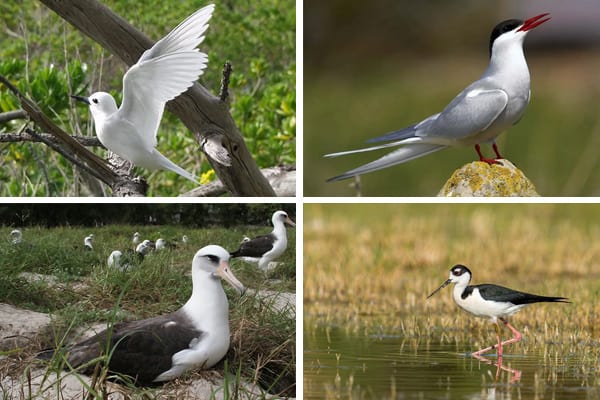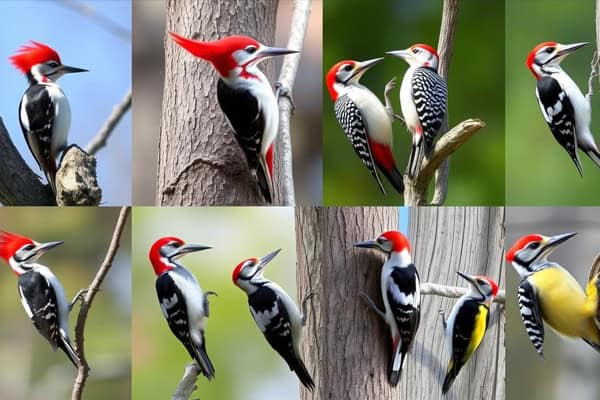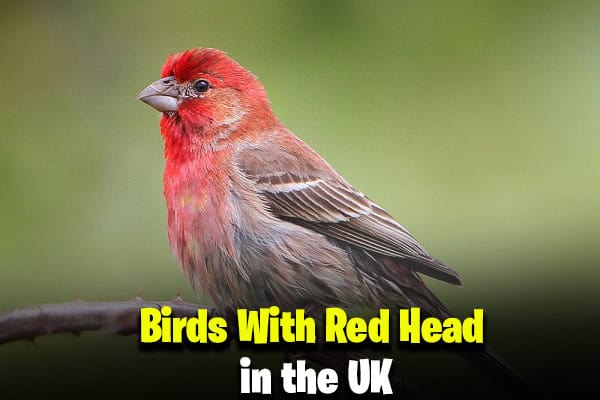7 Types Of White Birds in Hawaii (ID Guide With Pictures)
Hawaii is home to an extraordinary array of wildlife, and among its most captivating inhabitants are the white birds that dot its skies and landscapes. These birds, striking in their beauty, symbolize the island’s rich natural heritage and integral components of its delicate ecosystems. White birds in Hawaii add visual charm to the tropical paradise and play vital roles in maintaining ecological balance. In this article, we’ll explore the types of white birds found in Hawaii, their significance, where you can spot them, and their crucial roles in Hawaiian ecosystems.
Main Points:
- Hawaii is home to various species of white birds, each bringing its unique characteristics to the islands.
- Birdwatching in Hawaii allows spotting rare and beautiful species in diverse habitats, from wetlands to urban landscapes.
- Conservation efforts are crucial to preserving these species and ensuring they continue to thrive in their natural ecosystems.
7 White Bird Species Found in Hawaii Including (Common & Rare)
The white birds of Hawaii vary in size, habitat preferences, and ecological roles. Some species are native to the islands, while others were introduced but have since become part of Hawaii’s complex natural landscape. Let’s take a closer look at some of the most notable species you can encounter.
1. Great White Egret (Ardea alba)
- Scientific Name: Ardea alba
- Size: 85–102 cm (33–40 in)
- Weight: 700–1,500 g (1.5–3.3 lb)
- Lifespan: Up to 15 years in the wild
- Diet: Primarily fish, amphibians, and small invertebrates
The Great White Egret, a large heron with an elegant, slender neck and long legs, is one of the most recognizable white birds in Hawaii. These birds are primarily found in wetlands, ponds, and coastal areas, where they gracefully stalk their prey, usually fish and amphibians.

Physical Characteristics: The Great White Egret is characterized by its stunning white plumage, long neck, and yellow beak, which contrasts against its black legs. During the breeding season, these birds develop delicate, ornamental plumes on their backs, which were once coveted by the fashion industry, leading to their near extinction in the late 19th century.
Habitat: In Hawaii, the Great White Egret is commonly seen in wetlands and shallow coastal areas, where it feeds on a variety of aquatic creatures. Their ability to thrive in different types of wetland environments makes them a common sight near the islands’ ponds and marshes.
Conservation and Significance: Although the Great White Egret was heavily hunted for its feathers, it has made a remarkable comeback, thanks to conservation efforts. In Hawaii, it represents a symbol of ecological recovery and resilience, serving as a reminder of the importance of wetland conservation.
2. White Tern (Gygis alba)
- Scientific Name: Gygis alba
- Size: 28–35 cm (11–14 in)
- Weight: 90–150 g (3.2–5.3 oz)
- Lifespan: Up to 20 years in the wild
- Diet: Primarily small fish and invertebrates, often caught by diving.
The White Tern, also known as Manu-o-Kū in Hawaiian, is a striking bird that is particularly well-known in urban Honolulu. These birds are small, with pure white plumage and black, beady eyes, giving them a ghostly and ethereal appearance as they flit through the sky.
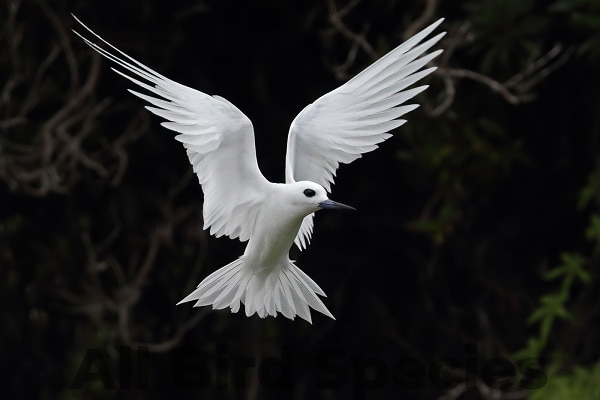
Physical Characteristics: Unlike many seabirds, the White Tern does not build a traditional nest. Instead, it lays a single egg on bare branches or ledges, showcasing a remarkable balance that seems almost impossible in windy conditions.
Habitat: The White Tern has adapted to life in urban settings, particularly in the capital city of Honolulu. They are commonly spotted nesting on trees and ledges in urban areas, which is rare for a seabird. The presence of the White Tern in such areas has made them an iconic species in Oahu.
Cultural Significance: The White Tern holds a special place in Hawaiian culture and is considered a protected species under state law. For Hawaiians, it symbolizes peace and harmony, often associated with ancient legends that speak of the bird guiding sailors to shore.
3. Hawaiian Petrel (Pterodroma sandwichensis)
- Scientific Name: Pterodroma sandwichensis
- Size: 38–46 cm (15–18 in)
- Weight: 500–700 g (1.1–1.5 lb)
- Lifespan: Up to 30 years in the wild
- Diet: Primarily fish, squid, and crustaceans, often foraged at sea
The Hawaiian Petrel, though not entirely white, boasts a white underside that sharply contrasts its dark wings. This seabird is a pelagic species, meaning it spends much of its life over open oceans, only coming to land to breed.

Physical Characteristics: The Hawaiian Petrel is medium-sized, with a white belly and chest, and blackish wings and back. Its sharp bill and agile flight patterns make it a master of the open ocean.
Habitat: The Hawaiian Petrel nests in high-elevation colonies, often in remote areas of the islands. After the breeding season, they migrate across the Pacific, spending months at sea before returning to their nesting grounds.
Conservation Status: Unfortunately, the Hawaiian Petrel is listed as an endangered species, with threats including habitat loss, predation by introduced species such as rats, and environmental changes. Conservation efforts are underway to protect its nesting sites and reduce threats from human activities.
4. Cattle Egret (Bubulcus ibis)
- Scientific Name: Bubulcus ibis
- Size: 46–56 cm (18–22 in)
- Weight: 250–500 g (8.8–17.6 oz)
- Lifespan: Up to 15 years in the wild
- Diet: Primarily insects, small mammals
The Cattle Egret, introduced to Hawaii in the mid-20th century, has since become a familiar sight in the fields and grassy plains of the islands. These birds are often found following livestock, feeding on insects stirred up by the movement of cattle and horses.
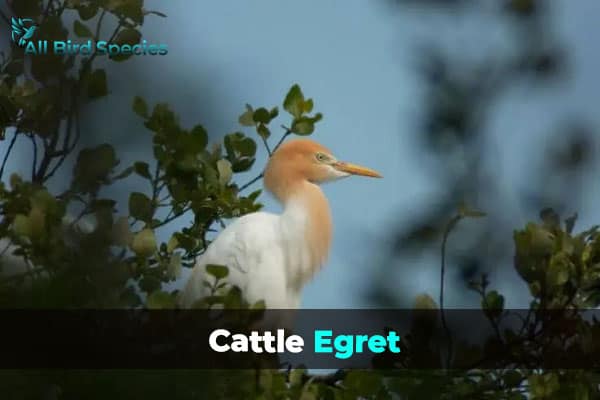
Physical Characteristics: The Cattle Egret is smaller than the Great White Egret and has a shorter, stockier build. It is mostly white, with patches of yellowish-buff feathers during the breeding season and a bright yellow bill.
Habitat: Cattle Egrets are opportunistic feeders, thriving in areas with livestock. They are commonly found in pastures and grassy areas, where they help control insect populations by feeding on grasshoppers, crickets, and other pests.
Impact on Local Ecosystem: Though not native, the Cattle Egret plays a beneficial role in controlling insect populations. However, their presence has raised concerns about competition with native bird species for resources.
5. Red-Tailed Tropicbird (Phaethon rubricauda)
- Scientific Name: Phaethon rubricauda
- Size: 76–90 cm (30–35 in) including tail
- Weight: 500–1,100 g (1.1–2.4 lb)
- Lifespan: Up to 30 years in the wild
- Diet: Primarily fish and squid, caught by diving
While the Red-Tailed Tropicbird is not fully white, its primarily white body and striking red tail feathers make it a noteworthy addition to this list. These elegant birds are often seen gliding above cliffs or out at sea.

Physical Characteristics: The Red-Tailed Tropicbird is easily identifiable by its elongated red tail feathers and sharp, angular wings. Its stark white plumage helps it blend in with the sea foam when viewed from above.
Habitat: Found mostly around coastal cliffs and offshore islets, the Red-Tailed Tropicbird nests in secluded, hard-to-reach areas. It spends much of its time at sea, where it feeds on fish and squid, diving gracefully into the water to catch its prey.
Conservation Concerns: Like many seabirds, the Red-Tailed Tropicbird is vulnerable to habitat loss and predation by introduced species. Conservation efforts focus on protecting nesting sites and reducing human disturbance in these areas.
Why Are White Birds Important to Hawaii’s Ecosystem?
The white birds in Hawaii aren’t just visually stunning; they play key roles in maintaining the islands’ ecosystems. These birds help sustain ecological balance by participating in various crucial processes.
1. Pollination and Seed Dispersal
While many white birds, such as the Hawaiian Petrel and White Tern, primarily consume fish and insects, certain species contribute indirectly to pollination and seed dispersal. Birds that frequent coastal and wetland areas help maintain the health of these environments, which in turn supports plant life.
2. Insect Population Control
Species like the Cattle Egret are vital for controlling insect populations in Hawaii. By feeding on grasshoppers, crickets, and other pests, these birds reduce the need for chemical pesticides, which can harm the environment. Their presence benefits both local agriculture and the natural ecosystem.
3. Marine and Coastal Ecosystems
Many of Hawaii’s white birds, such as the Red-Tailed Tropicbird and Great White Egret, depend on marine and coastal ecosystems for survival. These birds contribute to the health of these environments by controlling fish populations and keeping coastal ecosystems in balance. Their presence indicates the health of marine food chains and supports biodiversity.
4. Maintaining the Food Chain
White birds in Hawaii are both predators and prey, forming an essential part of the island’s food chain. Birds like the Great White Egret and White Tern help keep fish and insect populations in check while they, in turn, provide sustenance for larger predators, including humans, in traditional fishing practices.
Where to Spot White Birds in Hawaii
Hawaii’s diverse landscapes offer numerous opportunities to spot white birds. Here are some prime locations where birdwatchers can see these stunning creatures in their natural habitats:
1. Kahana State Park, Oahu
Located on Oahu’s northeastern coast, Kahana State Park is a haven for birdwatchers. The park’s wetlands are home to the Great White Egret and other wading birds, making it an ideal spot for observing these elegant creatures.
2. Kilauea Point National Wildlife Refuge, Kauai
This refuge on the island of Kauai is famous for its seabirds, including the Red-Tailed Tropicbird. With its dramatic coastal cliffs and ocean views, it’s one of the best places in Hawaii to watch seabirds in flight.
3. Waihee Coastal Dunes and Wetlands, Maui
Maui’s Waihee Coastal Dunes offer a mix of wetland and coastal habitats that attract a variety of white birds, including the Cattle Egret. Birdwatchers can explore the area’s trails while enjoying scenic views of the ocean.
4. Honolulu, Oahu (Urban Birdwatching)
If you’re in the city, Honolulu is the best place to see the White Tern in an urban setting. These birds nest in trees and on buildings, providing a unique birdwatching experience in the heart of the city.
Conservation Efforts and Challenges
Hawaii’s white birds face several threats, including habitat destruction, invasive species, and climate change. Conservation efforts are crucial for protecting these birds and ensuring they continue to thrive in their natural habitats.
1. Habitat Preservation
Organizations and government agencies are working to preserve critical habitats for Hawaii’s white birds. Wetlands, coastal areas, and high-elevation nesting sites are being protected through various conservation programs.
2. Control of Invasive Species
Invasive predators like rats and mongoose pose a significant threat to nesting birds, particularly seabirds like the Hawaiian Petrel. Efforts to control these predators are essential for the survival of vulnerable bird species.
3. Public Awareness and Education
Raising public awareness about the importance of Hawaii’s white birds is key to their conservation. Educational programs and birdwatching tours help locals and visitors understand the importance of protecting these species and their habitats.
Read More🐦Related Articles:
- Doves in Illinois
- Small Birds With Long Necks
- Hummingbirds In Kansas
- Doves (Pigeons) That Live in Kansas
- Spiritual Meaning of Dead Birds
- Kingfisher Bird
Conclusion
The white birds in Hawaii offer a glimpse into the islands’ rich biodiversity and play essential roles in maintaining the ecological balance of these tropical environments. From the elegant Great White Egret to the culturally significant White Tern, each species contributes uniquely to the ecosystem. Conservation efforts are vital to ensuring these birds continue to thrive, allowing future generations to witness their beauty and significance.
For those looking to connect with nature, birdwatching in Hawaii is a rewarding experience that offers the chance to see some of the world’s most beautiful and unique birds in their natural habitats.

